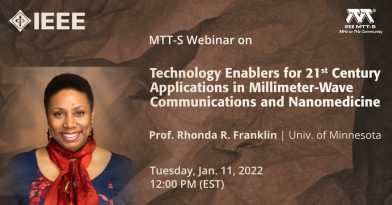
-
Tuesday, January 11, 2022 12:00 pm - 1:00 pm(New York Time) Add to my calendar
Technology Enablers for 21st Century Applications in Millimeter-wave Communications and Nanomedicine
Prof. Rhonda R. Franklin
University of Minnesota, USA
Abstract: Over two decades ago, we imagined wireless technology and integrated portable devices with computing, communications, and imaging that could offer anytime anywhere access for communicating, sensing, and data sharing. Today, this is reality and this is the result of advances in (1) different technology areas, (2) integration and packaging technology, and (3) microelectronics fabrication. These solutions motivated investments in technology development for the Internet of Things and 5G.
Now, new technology concepts are being imagined, such as mobile autonomous systems with artificial intelligence and quantum computing, to support concept development of smart cities, agriculture, and health. These new concepts demand more advances at the intersection of different technology areas and even higher levels of integration within/between systems that can operate over broader aspects of the electromagnetic spectrum (i.e., several GHz to several hundred GHz). Moreover, for operation above millimeter wave frequencies, power consumption management remains a serious challenge due to the inherent power reduction of devices as operating frequencies increase. Advances in design methods and fabrication approaches that use different materials, therefore, are needed that can reduce power consumption, offer high integration capability at low cost.
This talk will highlight a few enabling technologies we have been investigating to support advancement of communication systems above mm-wave frequencies and bio-labels for nanomedicine. For communications, design concepts to make virtual antennas with high gain and high directivity as well as vertical free-space interconnects for 3D integration will be discussed. Copper nanowire technology will also be described for low-loss vertical interconnects. For nanomedicine, the ferromagnetic resonance (FMR) frequency in magnetic nanowire is described to form FMR-ID nanolabels that can be used as bio-markers in cancer detection.
Speaker’s Bio: Rhonda R. Franklin received her B.S. from Texas A&M University, and M.S. and Ph.D. from the University of Michigan in Electrical Engineering. She is a professor of electrical and computer engineering at University of Minnesota. Her research investigates design of circuits, antennas, integration and packaging techniques, and characterization of electronic materials and magnetic nanomaterials for communication, biomedical and nanomedicine applications. She has co-authored over 130 referred conference and journals, six book chapters and has three patents.
She received the National Science Foundation’s Presidential Early Career Award for Scientists and Engineers and 3M Non-Tenured Faculty Award. She is active in the IEEE MTT Society as an associate editor of MWCL, member of the inaugural editorial board of Journal of Microwaves, chaired IMS TPRC sub-committees, student paper competitions and the undergraduate scholarship committee. She is a co-founder of IMS Project Connect and is the recent-Chair of MTT-S Technical Coordinating Committee for Integration and Packaging. She received the 2019 IEEE N. Walter Cox Service Award (MTT-S) and 2022 IEEE Diversity and Inclusion (IEEE MGA) award for her leadership of Project Connect. At University of Minnesota, she received the 2014 Sara Evans Faculty Scholar Leader Award, 2017 John Tate Advising Award, 2018 Willie Hobbs Moore Distinguished Alumni Lecture Award (University of Michigan), 2020 ARCS Minnesota Scientist of the Year, 2020 Institute for Engineering and Medicine’s Abbott Professorship for Innovative Education, and 2021 CSE Distinguished Service Award.
This event is sponsored by Cadence.
